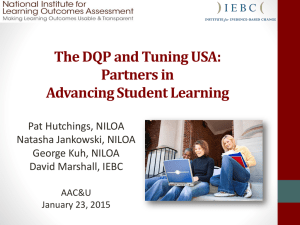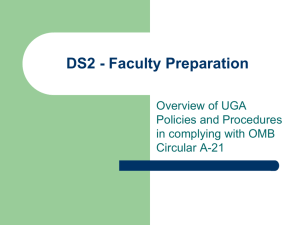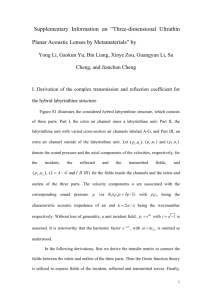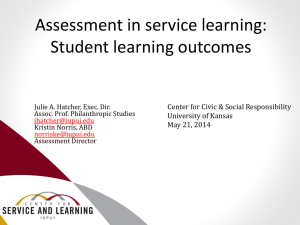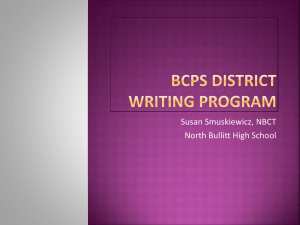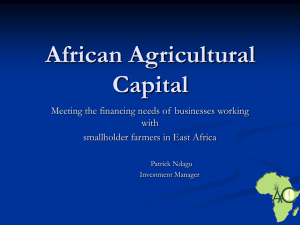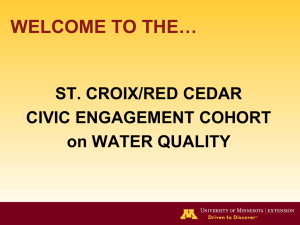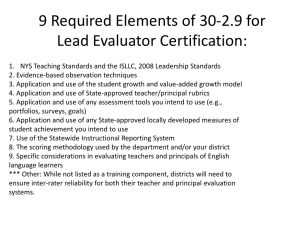the PowerPoint Presentation
advertisement
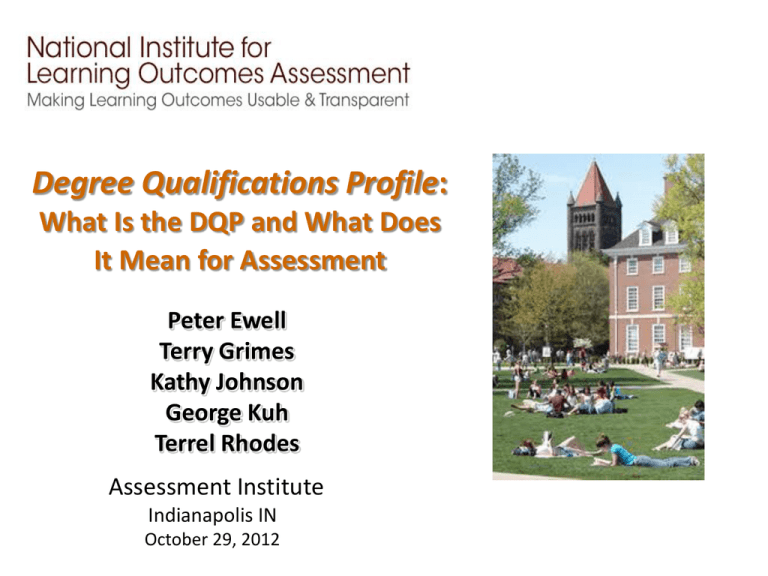
Degree Qualifications Profile: What Is the DQP and What Does It Mean for Assessment Peter Ewell Terry Grimes Kathy Johnson George Kuh Terrel Rhodes Assessment Institute Indianapolis IN October 29, 2012 Overview Origins of the DQP – Peter Ewell CIC DQP project – Terry Grimes AAC&U DQP Quality Collaboratives – Terry Rhodes Ivy Tech-IUPUI Collaborative – Kathy Johnson NILOA and the DQP NILOA NILOA’s mission is to discover and disseminate effective use of assessment data to strengthen undergraduate education and support institutions in their assessment efforts. ● SURVEYS ● WEB SCANS ● CASE STUDIES ● FOCUS GROUPS ● OCCASIONAL PAPERS ● WEBSITE ● RESOURCES ● NEWSLETTER ● LISTSERV ● PRESENTATIONS ● TRANSPARENCY FRAMEWORK ● FEATURED WEBSITES ● ACCREDITATION RESOURCES ● ASSESSMENT EVENT CALENDAR ● ASSESSMENT NEWS ● MEASURING QUALITY INVENTORY ● POLICY ANALYSIS ● ENVIRONMENTAL SCAN ● DEGREE QUALIFICATIONS PROFILE www.learningoutcomesassessment.org To increase the proportion of Americans with high-quality degrees and credentials to 60 percent by 2025. Background Qualifications Frameworks in Many Other Countries Bologna Process Common Outcomes Benchmarks (e.g. “Dublin Descriptors”) AAC&U LEAP Outcomes Statements and Rubrics State-Level Outcomes Frameworks in U.S. (e.g. UT, WI, CSU, ND, VA) Some Alignment of Cross-Cutting Abilities Statements Among Institutional Accreditors Lumina Degree Qualifications Profile • Three Degree Levels: Associate, Bachelor’s, and Master’s • Five Learning Areas: Specialized Knowledge, Broad/Integrative Knowledge, Intellectual Skills, Applied Learning, and Civic Learning Degree Qualifications Profile Applied Learning Civic Learning Intellectual Skills Associate Broad, Integrative Knowledge Bachelor Master’s Specialized Knowledge Lumina Degree Qualifications Profile • Three Degree Levels: Associate, Bachelor’s, and Master’s • Five Learning Areas: Specialized Knowledge, Broad/Integrative Knowledge, Intellectual Skills, Applied Learning, and Civic Learning • Framed as Successively Inclusive Hierarchies of “Action Verbs” to Describe Outcomes at Each Degree Level • Intended as a “Beta” Version, for Testing, Experimentation, and Further Development Beginning this Year How the Panel Approached Its Work • Wide Literature Review (Other National QFs and Outcomes Adopted by U.S. Colleges and Universities) • Emphasis on Application and Integration (as Distinctively “American” Undergraduate Attributes) • But Confined to Things that Institutions Actively Teach (Therefore Few Values or Attitudes Included) • Emphasized Civic Learning as an Area Particularly Important for a Functioning Democracy An Example: Communication Skills Associate Level: The student presents substantially error-free prose in both argumentative and narrative forms to general and specialized audiences Bachelor’s Level: The student constructs sustained, coherent arguments and/or narratives and/or explications of technical issues and processes, in two media, to general and specialized audiences Master’s Level: The student creates sustained, coherent arguments or explanations and reflections on his or her work or that of collaborators (if applicable) in two or more media or languages, to both general and specialized audiences An Example: Engaging Diverse Perspectives Associate Level: Describes how different cultural perspectives would affect his or her interpretations of prominent problems in politics, society, the arts, and/or global relations Bachelor’s Level: Constructs a cultural, political, or technological alternative vision of either the natural or human world, embodied in a written project, laboratory report, exhibit, performance, or community service design; defines the distinct patterns in this alternative vision; and explains how they differ from current realities Master’s Level: Addresses a core issue in his/her field of study from the perspective of either a different point in time, or a different culture, political order, or technological context, and explains how the alternative perspective contributes to results that depart from current norms, dominant cultural assumptions, or technologies—all demonstrated through a project, paper, or performance What Happens Next? Growing Number of Lumina-Funded Follow-On Projects Designed to “Test Drive” the DQP (HLC, WASC, SACS, CIC, AASCU, AAC&U, Community Colleges) Involving More than 120 Institutions Integral to teaching and learning, not an add-on “exoskeleton” Regional Accreditors •ACCJC (15) •HLC (23) •SACS (22) •WASC (28) Organizations •AASCU (6 in 3 state systems) •AAC&U (21) •CIC (25) States •Oregon (24) Lumina-Funded Projects http://www.learningoutcomesassessment.org/DQPNew.html#Funded What Happens Next? Growing Number of Lumina-Funded Follow-On Projects Designed to “Test Drive” the DQP (HLC, WASC, SACS, CIC, AASCU, AAC&U, Community Colleges) Involving More than 120 Institutions Integral to teaching and learning, not an add-on “exo-skeleton” NILOA Role to “Harvest” the Lessons Learned in these Projects [as well as others using the DQP outside the Lumina project universe] Results of Projects (and other efforts) Will be Used to Refine the DQP Further in 2014. CIC DQP CONSORTIUM 25 institutions from CIC with teams of 3 Purpose: enhance student learning Initiatives already in place or planned Areas of learning challenging to assess CIC Consortium 16 14 12 10 8 6 4 2 0 Strategic Planning Transfer & Accreditation Program Curriculum Assessment Discussion & Clarification Articulation Review & Mapping & of Learning Vetting of & Review of Development Revision DQP LO What’s Happening in the CIC Consortium A vehicle for fostering communication among faculty and staff and across disciplines and other units A framework for identifying and addressing high priority needs and goals across the campus Wide variety of projects Curricular mapping and alignment of outcomes is an essential step in process Foster communication across faculty/staff and disciplines/units • Holy Names University – involved faculty advisory group, general education steering committee, and lunch time discussions • Bethel University - improved communication between faculty who teach general education courses • Berry College – prompted discussions between academic and student affairs about high-impact practices • Concordia University Wisconsin – realized the need to diversify the group involved in the project Wide range of project foci • • • • • • • • • • • General Education Co-curricular transcripts Transfer Student persistence Study abroad Program development Senior-year experience Integrate liberal arts and business Assess current degree offerings Connect academic and student affairs And more… Curricular mapping and alignment of outcomes are key • Nebraska Methodist College mapped the DQP to Educated Citizen Core Curriculum Outcomes • Baldwin Wallace University mapped the DQP areas to its Undergraduate Student Learning Outcomes and prepared a curriculum map for three programs • Westminster College compared its college-wide learning goals with the associate level outcomes to determine overlap between the two • McKendree University cross walked the DQP to its student learning outcomes SOME DISCOVERIES: • STUDENT LEARNING OUTCOMES Not clear Not assessed No consensus on interpretation •CURRICULUM MAPPING No systematic plan for ratcheting • FEAR OF DATA INUNDATION • SCOPE OF DQP A CHALLENGE SOME METHODS USED IN PROJECTS 1. Crosswalking with NSSE, CLA, etc. 2. Mapping DQP to General Education, etc. 3. Home grown surveys on student perception 4. Student and faculty focus groups on learning outcomes 5. Rubric workshops to create and test rubrics based on DQP areas of learning. 6. Workshops on creating and assessing course embedded signature assignments 7. Extensive data audits to find what already existed. 8. Create opportunities for peer feedback on assessments. Quality Collaboratives Terrel L. Rhodes Association of American Colleges and Universities Assessment Institute October 2012 Why Did AAC&U Join the DQP Effort? Focus on Student Performance Research Projects Papers Performances Creative Works Quality Collaboratives National Advisory Panel Nine states California State University System Oregon Utah North Dakota Wisconsin Indiana Kentucky Virginia Massachusetts – university systems and state higher education commission offices Twenty campus QC’s – 2 and 4 year transfer partners Connections – OR – community college lead project with OUS; ND – HLC and NDSU; AASCU – 3 states – NY, GA, TX – civic engagement State QC Partners CSU-Northridge and Pierce CC: University of Utah and Salt Lake CC U of Wisconsin – Oshkosh and UW – Fox Valley; UW – Parkside and UW – Waukesha IUPUI and Ivy Tech CC U of Louisville and Elizabethtown Community and Technical College James Madison University and Blue Ridge CC; Virginia Commonwealth University and J. Sargent Reynolds CC U Mass – Lowell and Middlesex CC; Fitchburg State U and Mount Wachusett CC Faculty Collaboration The DQP Asks Us to Shift... from My Work to OUR Work Assessment Practices That Verify Achievement Valid Assessment of Learning in Undergraduate Education (VALUE) Rubrics Inquiry and analysis Critical thinking Creative thinking Written communication Oral communication Reading Quantitative literacy Information literacy Teamwork Problem solving Civic knowledge and engagement Intercultural knowledge and competence Ethical reasoning and action Foundations and skills for lifelong learning Integrative learning Ivy Tech Central Indiana and IUPUI Quality Collaboratives Partnership Recent Legislation in Indiana • Caps of 120 credits per baccalaureate degree; 60 credits per associate degree • Creation of a 30-hour transferable general education core based on 6 competency domains – – – – – Written communication Scientific thinking Speaking and listening Quantitative reasoning ‘Ways of Knowing’ • Arts and Humanities • Social and Behavioral Sciences Indiana QC Focus • How can we ensure that students transferring from Ivy Tech Central Indiana to IUPUI continue to succeed? • Can we use the DQP to guide discussions of curricular alignment connected to the Statewide Transferable Core? • Can we use DQP associate-level competencies to develop shared assessment rubrics in Writing and in Engineering? Our Approach • Gather instructors from both institutions for professional development workshops – either inperson or through videoconferencing • Limiting focus to Writing (including Composition and Technical Communication) and PreEngineering/Engineering makes project more manageable • Project also serves as vehicle for keeping faculty connected to state-wide work on general education Dynamic Criteria Mapping (DCM) • Process used to foster ‘organic assessment’ among faculty • Creates normative criteria by building them inductively and collaboratively from review of student artifacts – Following review of artifacts, faculty nominate characteristics that they value in student work • Values can then be mapped back to DQP to create common assessment rubrics • Writing Faculty – day-long workshop in July ’12 • Engineering Faculty – will repeat process (using preengineering project artifacts) this spring Challenges • Faculty teaching a single course/courses have difficulty shifting from ‘what I do’ to ‘what we do’ – particularly part-time faculty • Different levels of support for professional development and different teaching loads at 2-year and 4-year institutions • While some ‘faculty champions’ have emerged, some are deeply concerned about resources that transfer portfolios will demand Next Steps • Develop a transfer student portfolio that can store direct evidence of student learning/mastery of associate-level competencies • Continue faculty development efforts, particularly in support of creation of General Education Core at IUPUI NILOA’s role with the DQP NILOA is “harvesting” (collecting, analyzing, summarizing, synthesizing) what can be learned from all of the funded and unfunded work currently going on with the DQP NILOA and the DQP Document what is being done, by whom, and distill lessons learned in current DQP projects at the campus/system level—tracking current and relevant future work; Share your DQP story? What are you doing? Who is involved? What are you learning? What assistance do you need? Tell us via the DQP Institutional Activity Report: https://illinois.edu/fb/sec/704337 What We’re Learning Across Projects DQP is a conversation starter: offers a common vocabulary for talking about outcomes Curricular mapping: Where are students mastering these competencies? Where are the gaps? Certify transfers, align and “streamline” systems Faculty engagement and ownership are essential, which take time Doing assessment right is a continuing, perennial challenge. Faculty must drive assessment Identify which competencies described in the DQP they address in their courses/ labs/studios Identify which competencies are major objectives (probably only a few) Map those competencies to the existing relevant assignments Tweak existing or create new assignments/ student work to elicit the appropriate student behavior Faculty must drive assessment Validate competence through assignments: – lab specifications – test questions – performance protocols – exhibit instructions – field work questions – paper topics with rubrics www.learningoutcomeassessment.org NILOA Website Includes: New to the DQP? • Orientation or starting point to learn more DQP In Practice • Institutions working with the DQP are featured, outlining successes and challenges DQP Community Forum • Open to the public, the Community Forum is a message board to facilitate discussion of the DQP, to share ideas & troubleshoot challenges DQP Calendar • Calendar outlines conferences and other venues where DQP-related sessions will occur DQP Resource Kit • Information and tools - literature and responses to frequently asked questions regarding the DQP • DQP Resource Kit: – – – – – – – – – – – – – – Applied and Integrative Learning Assessment Change Management Competency-based Education Course-embedded assignments Curriculum Mapping Data Audit Faculty Engagement Prior Learning Rubrics Signature Assignments Student Affairs & Co-Curriculum Transfer/Articulation Tuning Questions & Discussion www.learningoutcomeassessment.org
